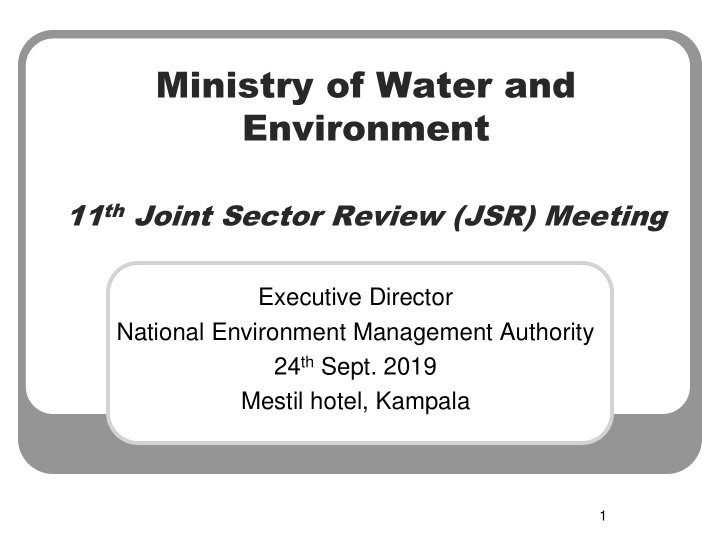



Ministry of Water and Environment 11 th Joint Sector Review (JSR) Meeting Executive Director National Environment Management Authority 24 th Sept. 2019 Mestil hotel, Kampala 1
Brief about NEMA The National Environment Management Authority 1. (NEMA) is a semi-autonomous institution. Established in May 1995 under the National 2. Environment Act (NEA) CAP, 153. NEMA is the principal agency charged with the mandate 3. of coordinating, monitoring, regulating and supervising all environmental management issues in Uganda. 2
Performance trend(Indicators) Environment Impact Social Assessment (ESIA) Fig 1: Number of ESIAs approved in 1126 out of 1836 EIA FY 2018/19 by NEMA certificates were approved by end of June 2019 as seen in 344 332 Figure 1. 227 221 Key projects received by NEMA in FY 2018/19 include; fuel stations (22.8%), ICT(22%), Q1 Q2 Q3 Q4 infrastructure (21.1%), EIA APPROVED IN FY 2018/19 and Industries (14.7%) among others. Wednesday, October 16, 2019 3
Performance trend(Indicators) Protection & restoration of fragile ecosystems 4,000ha of fragile ecosystems around the country have been restored or protected. These include; the Rwizi catchment, River Muzizi Lakeshores, Kyetinda wetland, Lake Kachera, Lake Victoria lakeshores Upper Kafu, and Oliduru CFR among others. Key issues to note; The approach used is community based natural resource management to inform public education during restoration activities. Politics plays a negative or positive role in restoration. Community participation in planting of the shea Protection of ecosystem butter seedlings in Oliduru central forest reserve guarantee improvement of the environment. Wednesday, October 16, 2019 4
Post ESI SIA in insp spections an and Audits in in FY FY 20 2018 18/19 Number of post ESIAs and Audits undertaken in 1, 395 out of 1,400 inspections FY2018/19 and audits were undertaken in 800 FY 2018/19. The majority of Environmental 700 Audits (EAs) reports handled were from the Telecom and 600 industrial sectors which further shows the increasing service 500 delivery demand on NEMA as already noted within the ESIA 400 review process. 300 Issues to note; 200 The main concerns noted during the EA review processes were 100 water and air pollution due to failure to meet the effluent 0 inspections Audits discharge standards, emissions to air beyond the recommended July to Sept. 2017 Jan to June 2018 standards set out in the draft Air Quality Regulations Wednesday, October 16, 2019 5
Challenges/Emerging issues 1. Increase in atmospheric pollution due to emission of noxious gases and noise. Particulate matter (PM2.5 and PM10) is the biggest contributor to air pollution from boilers, furnaces and incinerators in industrial facilities. 2. High demand for construction materials as well as extraction of construction materials (sand, rock, murram, water). 3. Increased residual impacts which include scarred landscape, soil/land degradation and in some cases draining of wetlands and disruption of the hydrology/drainage systems (which may affect the water catchment system);and, un-restored mines and murram/gravel borrow-pits posing a threat to human life, animals, among others. 3. Low capacity of local governments and Lead Agencies in ENR management due to inadequate funding, low staffing and limited equipment. Formulation of new districts which require a lot of technical and administrative support. 4. Environmental degradation with impunity by some investors who take advantage of the poor facilitation of local governments and MDAs. 6
Recommendations to address the challenges/Issues The Government of Uganda should enhance the capacity of local 1. governments and other lead agencies in environment and natural resources management by providing adequate conditional grant for project. Support continuous public education, awareness and literacy 2. programs to break-through the existing apathy and ensure that the people of Uganda and other stakeholders acknowledge and appreciate their roles and responsibilities to protect and conserve the environment for the current and future generations. The new National Environment Management Policy and the National 3. Environment Act, 2019 are expected to improve on institutional synergies and coordination especially in regard to enforcement. 7
Thank you 8
Recommend
More recommend